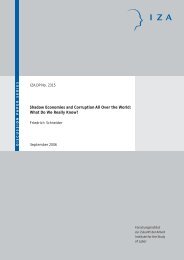The Great Recession of 2008-2009: Causes ... - Index of - IZA
The Great Recession of 2008-2009: Causes ... - Index of - IZA
The Great Recession of 2008-2009: Causes ... - Index of - IZA
- TAGS
- recession
- index
- ftp.iza.org
You also want an ePaper? Increase the reach of your titles
YUMPU automatically turns print PDFs into web optimized ePapers that Google loves.
4 Mitigating the effects <strong>of</strong> the crisis and securing a sustainable recovery:<br />
the effectiveness <strong>of</strong> policy responses<br />
As the global financial crisis unravelled, governments across the globe increasingly<br />
recognized the severity <strong>of</strong> the downturn and the urgency to intervene in order to avoid a<br />
catastrophic collapse <strong>of</strong> the financial markets and real economy. <strong>The</strong> response has consisted<br />
<strong>of</strong> three main interventions: 1) bailouts and injections <strong>of</strong> money into the financial system to<br />
keep credit flowing; 2) cutting interest rates to stimulate borrowing and investment; and 3)<br />
extra fiscal spending to shore up aggregate demand. <strong>The</strong>se measures have sought to prevent<br />
further economic deterioration and ultimately keep workers in jobs where possible and help<br />
create new jobs to provide opportunities for the unemployed. Overall, this response has<br />
helped avoid a far more severe downturn, though effectiveness has varied considerably across<br />
countries. In this context, this section summarizes both the macroeconomic and labour market<br />
policy responses.<br />
4.1 Macroeconomic policies, stimulus packages and the composition <strong>of</strong> policy<br />
interventions: an overview<br />
Systemically important nations, especially from the developed world, have engaged in<br />
historically unprecedented expansionary monetary policy, entailing both aggressive<br />
reductions in policy rates and quantitative easing. This has been combined with the<br />
assumption <strong>of</strong> contingent liabilities on behalf <strong>of</strong> the banking system (especially through<br />
deposit guarantee schemes) and massive support – running into trillions <strong>of</strong> dollars – for<br />
beleaguered financial institutions. At the same time, policymakers across the world held the<br />
view that monetary and financial policies alone could not cope with the global recession <strong>of</strong><br />
<strong>2008</strong>-<strong>2009</strong>. A UNDP study maintains that there are now 48 countries for which there are<br />
reliable data on fiscal stimulus packages. Collectively, the fiscal stimulus packages account<br />
for 3.9 per cent <strong>of</strong> world GDP (as measured in <strong>2008</strong>) and 4.8 per cent <strong>of</strong> their national GDPs.<br />
20 out <strong>of</strong> the 48 can be classified as developing countries. 39<br />
<strong>The</strong> UNDP study highlights the point that social protection expenditures account for a<br />
relatively modest proportion <strong>of</strong> the announced fiscal stimulus packages – about 25 per cent <strong>of</strong><br />
39 See Zhang et al. (2010).<br />
35
















